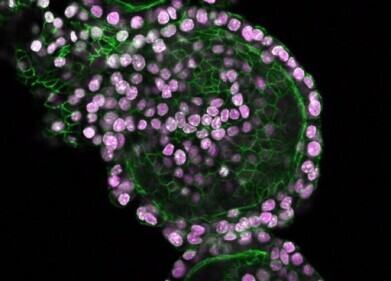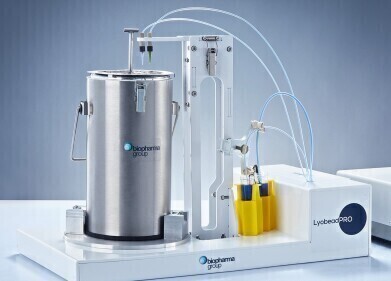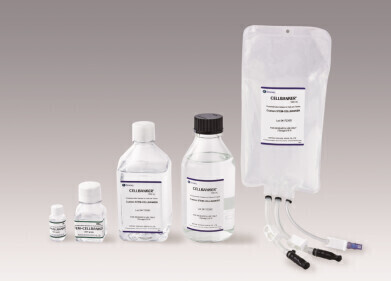-
 Figure 1: MM 500 control and its operating temperature range, related to the field of ball mills with water cooling, without cooling or cooling with liquid nitrogen.
Figure 1: MM 500 control and its operating temperature range, related to the field of ball mills with water cooling, without cooling or cooling with liquid nitrogen. -
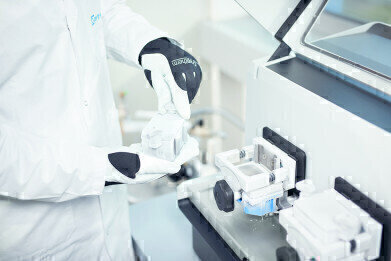 Figure 2: Cooling concept based on thermal plates: the sample material is processed in screw lock jars which are mounted on top of the thermal plates.
Figure 2: Cooling concept based on thermal plates: the sample material is processed in screw lock jars which are mounted on top of the thermal plates. -
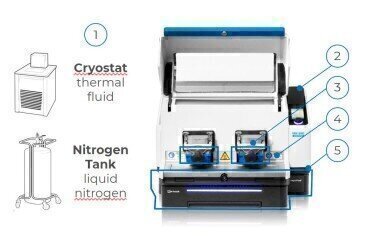 Figure 3: Key benefits and unique features of the MM 50 control: 1: Different setup possibilities, 2: temperature monitoring, 3: screw lock jars, 4: thermal plates, 5: cryoPad technology. Numbers are explained in detail in the text.
Figure 3: Key benefits and unique features of the MM 50 control: 1: Different setup possibilities, 2: temperature monitoring, 3: screw lock jars, 4: thermal plates, 5: cryoPad technology. Numbers are explained in detail in the text. -
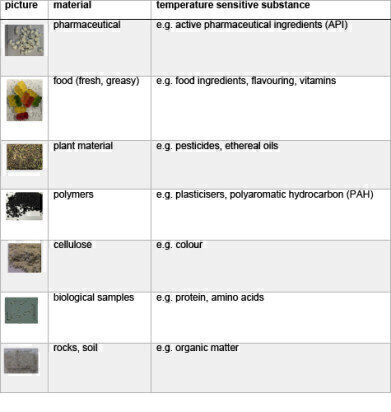 Table 4: Examples for temperature-sensitive materials. For every sample material substances are listed which will be affected by heat development.
Table 4: Examples for temperature-sensitive materials. For every sample material substances are listed which will be affected by heat development. -
.jpg) Figure 5: Fineness and temperature development in a wet grinding process as a function of time. Jars are cooled with water, which is provided by a chiller set to 4°C and the temperature stays below room temperature.
Figure 5: Fineness and temperature development in a wet grinding process as a function of time. Jars are cooled with water, which is provided by a chiller set to 4°C and the temperature stays below room temperature.
Cryogenic
A World First: Monitor and control the temperature of your grinding process with MM 500 control
Oct 11 2021
Author: Dr Lena Weigold, Retsch GmbH.
An apparently trivial yet potentially challenging point in a sample homogenisation process is to preserve the sample in its original condition. Sample preparation in ball mills, for example, is based on the physical mechanism of impact and friction. These two mechanisms result in heat development which poses a severe problem for temperature-sensitive materials. The MM 500 control is the first laboratory ball mill especially designed to process temperature- sensitive materials.
The MM 500 control monitors and controls the temperature of a grinding process. With its maximum frequency of up to 30 Hz it is a powerful mill for dry, wet and cryogenic grinding processes. Furthermore, the MM 500 control features an innovative concept for sample cooling. The accessible temperature range covers an area from - 100 to 100°C, providing new approaches for sample cooling and cryogenic grinding, see Figure 1. Even sample heating is possible.
Cooling concept
In the MM 500 control, the material is processed in Retsch Screw Lock Jars, which are simply mounted on top of thermal plates for tempering {Figure 2). As the grinding jars are in metallic contact with the thermal plates, heat is effectively transferred from or to the jars. The thermal plates are in turn, tempered by a thermal fluid.
Technical innovations and advanced design
The technical innovations and the advanced design of the MM 500 control offers completely new features, see also Figure 3.
1. Different configurations:
The innovative internal tubing system allows to use either liquid nitrogen or another thermal fluid for sample tempering. Cooling can thus be realised with a standard cryostat or a liquid nitrogen tank. For the first time cryogenic temperatures can also be achieved without using liquid nitrogen.
2. Temperature monitoring:
The actual temperatures of the thermal plates are continuously displayed during a grinding process, providing valuable information about the heat development inside the jars.
3. Screw lock jars:
Screw lock jars allow easy handling of samples and a high throughput by using two jars simultaneously with a size of up to 125 ml each. Grinding equipment of zirconium oxide and tungsten carbide is also available for cryogenic grinding.
4. Thermal plates:
Allowing the indirect sample cooling and heating in a range from - 100 to +100°C.
5. cryoPad technology:
If liquid nitrogen is used for tempering, the mill must be extended with the optionally available cryoPad device extension. The cryoPad technology allows for the first time to select and maintain a specific cooling temperature for tempering. The accessible area, using liquid nitrogen for cooling, covers a range from -100 to 0°C, in steps of 10. The patented PID (proportional-integral-derivative) system of the cryoPad controls the flow of liquid nitrogen through the tubing system and effectively regulates the temperature at the thermal plates.
Application examples
Materials, which are affected by heat development are found in almost every field of application. Agriculture, biology, chemistry, plastics, engineering, recycling, pharmaceutical, food industry, and even geology show a need for sample cooling, see table 1.
Objectives of sample cooling / heating
The MM 500 control offers unique benefits to handle temperature-sensitive processes. With this device cumbersome sample precooling or time-consuming grinding breaks are not necessary. Regardless of any specific industry, four different objectives are identified that require sample cooling/ heating:
1. Preserve substances for analysis
Materials may change their physical or chemical structure, if heated up to elevated temperatures. This means the analyte of interest is not the same as before the sample preparation. Looking at volatile substances or at substances that evaporate at elevated temperatures, also the amount of an analyte can be noticeably modified by the heat development.
2. Embrittling
Ductile and sticky materials must be embrittled for homogenisation in ball mills. Not all samples require a temperature of -196°C as achieved with liquid nitrogen in typical cryogenic mills. The MM 500 control offers a convenient and safe cooling option with high throughput down to temperatures of -100°C.
3. Wet grinding below room temperature
Nano grinding is typically performed in wet grinding processes at high frequencies / rotations per minute. The required high energy input results not uncommonly in temperatures above 80°C. If jars are cooled with a thermal fluid, no cool-down breaks are necessary during the process and after finishing the sample preparation, see example in Figure 5. The temperature at the thermal plates is monitored throughout the whole process. Subsampling to check the fineness during a process is much easier than in other devices.
4. Mechanochemistry
Mechanochemistry and mechanical alloying processes require energy for initiating or intensifying material chemical reactions or the formation of material blends. An active heating of the jar may considerably improve the results of chemical reactions. On the other hand, the temperature regulation of the MM 500 control can also be used to maintain a chosen temperature level throughout the whole process and thereby allows to control the formation of chemical derivatives.
Conclusion
The Mixer Mill MM 500 control is a true World First: the first high energy laboratory ball mill that allows to monitor and control the temperature during a grinding process. This mill offers new perspectives and possibilities for the homogenisation of temperature-sensitive sample materials, cryogenic grinding or wet grinding processes and in the field of mechanochemistry.
Digital Edition
Lab Asia Dec 2025
December 2025
Chromatography Articles- Cutting-edge sample preparation tools help laboratories to stay ahead of the curveMass Spectrometry & Spectroscopy Articles- Unlocking the complexity of metabolomics: Pushi...
View all digital editions
Events
Jan 21 2026 Tokyo, Japan
Jan 28 2026 Tokyo, Japan
Jan 29 2026 New Delhi, India
Feb 07 2026 Boston, MA, USA
Asia Pharma Expo/Asia Lab Expo
Feb 12 2026 Dhaka, Bangladesh
